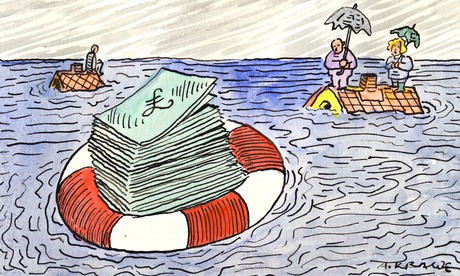Flood defences: George Osborne tackled yesterday's crisis at the cost of today's
The chancellor's flood defence cuts were driven by deficit reduction. But we can't continue learning by drowning

Illustration by Andrzej Krauze
..
There is no excuse. In 2010 the coalition slashed spending on flood defences when it should have gone up. Even last year's increase in flood defence spending was under duress. The insurers, some of the most enlightened big businesses on this issue, have repeatedly warned about the rising claims and losses from climate change-induced extreme weather.
A confidential deal struck last June, ahead of the spending review, increased flood defence spending as a payback for the insurance companies continuing to provide cover for 350,000 homes at high flood risk. The Association of British Insurers had the Treasury and Owen Paterson, the climate-sceptic environment secretary, over a barrel.
If the government had not increased flood defence spending, the insurers would have pulled cover. Since you cannot get a mortgage on a property without buildings insurance, and with one in six homes at some flood risk, that would have put a torpedo through the chancellor's housing market revival.
The 2010 cuts were entirely driven by the chancellor's impatience for deficit reduction, rather than by climate scepticism. This was long before Tory wobbles on windfarms and climate science. We tackled yesterday's crisis at the cost of today's. The proof is the divergence of the two Whitehall departments with responsibility for climate change.
Oddly, the budget for the Department for Environment, Food and Rural Affairs (which has responsibility for adapting to the impact of climate change and for the Environment Agency) was slashed. The budget for the Department of Energy and Climate Change (with responsibility for stopping future climate change, but also nuclear clean-up) suffered far less.
Nor did Defra at that stage have a climate sceptic in charge: Caroline Spelman is a diligent Cameroonian who respects the scientific evidence on climate change, and was effective in fighting Whitehall battles such as for a Green Investment Bank with borrowing powers. Spelman was unfairly sacked after a U-turn on forestry privatisation that was Downing Street's fault. But at the time of the spending review she had the ingenue's fatal weakness in the Whitehall jungle; she was like a team-playing head girl who put her hand up first, and settled early, when the Treasury came calling for cuts.
Whatever the Treasury says, it never gives spending ministers credit for being reasonable or early. Result? The capital budget at Defra was down 34% in real terms over the coalition's first spending review period – flood defences to the fore – while the capital budget at my old department was up 41%.
Why is Labour not making more of this coalition cock-up? Simple. The overall capital spending plans pursued by George Osborne after 2010 were the same as those laid down in 2009 by his predecessor, Alistair Darling. Labour planned to cut public capital spending – including flood defences – from £44bn in 2009-10 to £22bn in 2013-4. That was a decision, of course, that Ed Miliband and Ed Balls signed off as cabinet members. This was frankly nuts, as even someone as ideologically committed to a small state as the chancellor has now recognised: the coalition has recently been upping the spending on public investment across the board.
The flood defence story is particularly salutary, since the Environment Agency has been designing good schemes. Even though we've had the wettest January for 250 years, the flooding has done less damage to life and limb than in the past. So far, the number of people who have died as a result of the storms and flooding is just into double figures. In 1953 more than 300 people died in storm surge flooding on the east coast (where sea levels rise when water is pushed south down the narrowing North Sea). In 2007 flash floods killed 13 and are estimated to have caused £6bn of damage.
Global warming allows the air to carry more moisture, so that more intense and frequent storms and rainfall are an entirely predictable consequence, as Sir Michael Pitt's review of 2007 said. One of the most alarming features is the sudden downpour that can cause floods, even on high ground, as storm drains are overwhelmed.
We will have to adapt to climate change in ways most people have yet to fathom: flood defences, stronger roofing, road foundations, upgrading inadequate storm drains, and separating them from sewers. The cost is high, as the rows over the £4.2bn London super-sewer show.
The Tory climate sceptics' line is changing. Now they are arguing that we should be spending money on adapting, but not wasting it on trying to stop the problem. It is progress of a sort: learning by drowning. But it is absurd given the existence of two frightening accelerators. The first is that these storms are happening when we have only warmed 0.85C since 1880, and have another 1.15 degrees to go before the so-called "danger level" of 2 degrees above pre-industrial temperatures. The second is the evidence from the Foresight flood studies that a rise in rainfall intensity leads to four times the rise in flood damage.
Look out that rain-spattered window, and imagine the forces of nature that we will have to fight if we arrive at 5C warming and more, which is where we are heading without urgent action. It does not bear thinking about.
There is no excuse. In 2010 the coalition slashed spending on flood defences when it should have gone up. Even last year's increase in flood defence spending was under duress. The insurers, some of the most enlightened big businesses on this issue, have repeatedly warned about the rising claims and losses from climate change-induced extreme weather.
A confidential deal struck last June, ahead of the spending review, increased flood defence spending as a payback for the insurance companies continuing to provide cover for 350,000 homes at high flood risk. The Association of British Insurers had the Treasury and Owen Paterson, the climate-sceptic environment secretary, over a barrel.
If the government had not increased flood defence spending, the insurers would have pulled cover. Since you cannot get a mortgage on a property without buildings insurance, and with one in six homes at some flood risk, that would have put a torpedo through the chancellor's housing market revival.
The 2010 cuts were entirely driven by the chancellor's impatience for deficit reduction, rather than by climate scepticism. This was long before Tory wobbles on windfarms and climate science. We tackled yesterday's crisis at the cost of today's. The proof is the divergence of the two Whitehall departments with responsibility for climate change.
Oddly, the budget for the Department for Environment, Food and Rural Affairs (which has responsibility for adapting to the impact of climate change and for the Environment Agency) was slashed. The budget for the Department of Energy and Climate Change (with responsibility for stopping future climate change, but also nuclear clean-up) suffered far less.
Nor did Defra at that stage have a climate sceptic in charge: Caroline Spelman is a diligent Cameroonian who respects the scientific evidence on climate change, and was effective in fighting Whitehall battles such as for a Green Investment Bank with borrowing powers. Spelman was unfairly sacked after a U-turn on forestry privatisation that was Downing Street's fault. But at the time of the spending review she had the ingenue's fatal weakness in the Whitehall jungle; she was like a team-playing head girl who put her hand up first, and settled early, when the Treasury came calling for cuts.
Whatever the Treasury says, it never gives spending ministers credit for being reasonable or early. Result? The capital budget at Defra was down 34% in real terms over the coalition's first spending review period – flood defences to the fore – while the capital budget at my old department was up 41%.
Why is Labour not making more of this coalition cock-up? Simple. The overall capital spending plans pursued by George Osborne after 2010 were the same as those laid down in 2009 by his predecessor, Alistair Darling. Labour planned to cut public capital spending – including flood defences – from £44bn in 2009-10 to £22bn in 2013-4. That was a decision, of course, that Ed Miliband and Ed Balls signed off as cabinet members. This was frankly nuts, as even someone as ideologically committed to a small state as the chancellor has now recognised: the coalition has recently been upping the spending on public investment across the board.
The flood defence story is particularly salutary, since the Environment Agency has been designing good schemes. Even though we've had the wettest January for 250 years, the flooding has done less damage to life and limb than in the past. So far, the number of people who have died as a result of the storms and flooding is just into double figures. In 1953 more than 300 people died in storm surge flooding on the east coast (where sea levels rise when water is pushed south down the narrowing North Sea). In 2007 flash floods killed 13 and are estimated to have caused £6bn of damage.
Global warming allows the air to carry more moisture, so that more intense and frequent storms and rainfall are an entirely predictable consequence, as Sir Michael Pitt's review of 2007 said. One of the most alarming features is the sudden downpour that can cause floods, even on high ground, as storm drains are overwhelmed.
We will have to adapt to climate change in ways most people have yet to fathom: flood defences, stronger roofing, road foundations, upgrading inadequate storm drains, and separating them from sewers. The cost is high, as the rows over the £4.2bn London super-sewer show.
The Tory climate sceptics' line is changing. Now they are arguing that we should be spending money on adapting, but not wasting it on trying to stop the problem. It is progress of a sort: learning by drowning. But it is absurd given the existence of two frightening accelerators. The first is that these storms are happening when we have only warmed 0.85C since 1880, and have another 1.15 degrees to go before the so-called "danger level" of 2 degrees above pre-industrial temperatures. The second is the evidence from the Foresight flood studies that a rise in rainfall intensity leads to four times the rise in flood damage.
Look out that rain-spattered window, and imagine the forces of nature that we will have to fight if we arrive at 5C warming and more, which is where we are heading without urgent action. It does not bear thinking about.


No comments:
Post a Comment